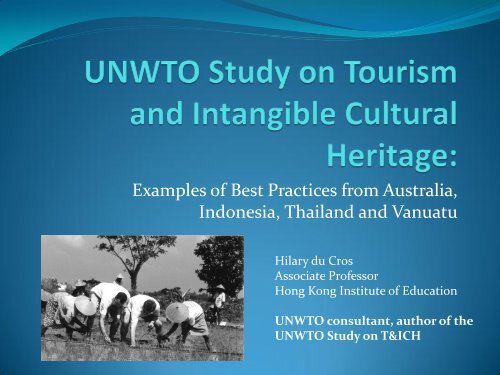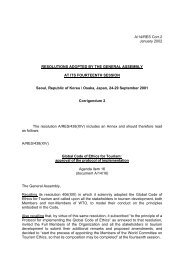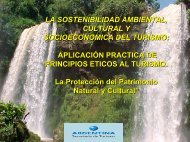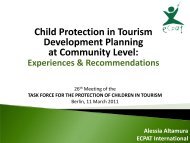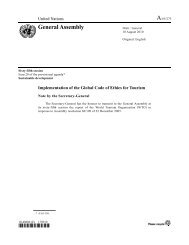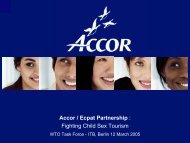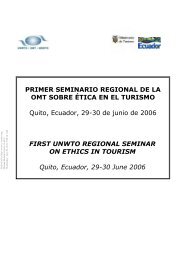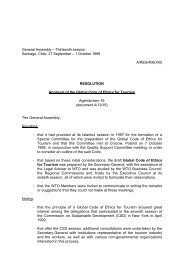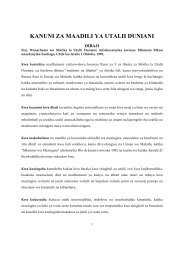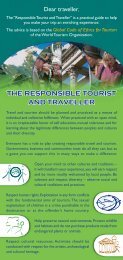Presentation of Ms. du Cros - Ethics and Social Dimensions of Tourism
Presentation of Ms. du Cros - Ethics and Social Dimensions of Tourism
Presentation of Ms. du Cros - Ethics and Social Dimensions of Tourism
Create successful ePaper yourself
Turn your PDF publications into a flip-book with our unique Google optimized e-Paper software.
Examples <strong>of</strong> Best Practices from Australia,<br />
Indonesia, Thail<strong>and</strong> <strong>and</strong> Vanuatu<br />
Hilary <strong>du</strong> <strong>Cros</strong><br />
Associate Pr<strong>of</strong>essor<br />
Hong Kong Institute <strong>of</strong> E<strong>du</strong>cation<br />
UNWTO consultant, author <strong>of</strong> the<br />
UNWTO Study on T&ICH
Intro<strong>du</strong>ction<br />
• The first UNWTO study on <strong>Tourism</strong> <strong>and</strong> Intangible Cultural<br />
Heritage (T&ICH) is sche<strong>du</strong>led for publication this summer<br />
Rationale:<br />
• Need to address gaps in tourism policy <strong>and</strong> project management<br />
involving intangible heritage by establishing a constructive dialogue<br />
between these sectors<br />
• Encourage the inclusion <strong>of</strong> intangible-cultural-heritage component<br />
in destinations’ tourism planning, development <strong>and</strong> management
Objectives <strong>of</strong> the UNWTO Study on T&ICH<br />
• Provide research on the interlinkages between tourism <strong>and</strong><br />
intangible cultural heritage (ICH), including risks <strong>and</strong><br />
opportunities;<br />
• Investigate government-led actions, PPPs <strong>and</strong> community<br />
initiatives in terms <strong>of</strong> tourism development <strong>and</strong> ICH;<br />
• Advise on practical steps for developing <strong>and</strong> managing ICHbased<br />
tourism pro<strong>du</strong>cts & destinations;<br />
• Present case studies <strong>and</strong> best practices from UNWTO Member<br />
States;<br />
• Recommend guidelines to policy makers & others to foster<br />
sustainable tourism development through safeguarding ICH.
Categories <strong>of</strong> Intangible cultural heritage<br />
1. H<strong>and</strong>icrafts <strong>and</strong> visual arts that demonstrate traditional craftsmanship<br />
2. Gastronomy *<br />
3. <strong>Social</strong> practices, rituals, <strong>and</strong> festive events<br />
4. Music <strong>and</strong> the performing arts<br />
5. Oral traditions <strong>and</strong> expressions, including language as a vehicle <strong>of</strong> ICH<br />
6. Knowledge <strong>and</strong> practices concerning nature <strong>and</strong> the universe<br />
* Gastronomy is not an <strong>of</strong>ficial UNESCO category <strong>and</strong> is used as such only for the purpose <strong>of</strong> this study
Use <strong>of</strong> case studies <strong>and</strong> best practice examples<br />
• More than 40 case studies <strong>and</strong> best practices from 5 continents<br />
• Lessons which can be useful <strong>and</strong> relevant to organizations wishing to<br />
develop ICH-based tourism pro<strong>du</strong>cts<br />
• Potential for addressing key issues for achieving sustainable <strong>and</strong><br />
responsible development <strong>of</strong> tourism<br />
• T&ICH pro<strong>du</strong>cts <strong>of</strong>ten include a mix <strong>of</strong> activities but usually contain<br />
aspects that are unique to the area or community concerned
Importance <strong>of</strong> ICH to communities: A Case Study<br />
from Australia<br />
Uluru-Kata Tjuta National<br />
Park/World Heritage Site<br />
• Inscribed on the WHS as a<br />
natural heritage property in<br />
1987 <strong>and</strong> as a cultural<br />
l<strong>and</strong>scape in 1994<br />
• Acknowledgement <strong>of</strong> the local<br />
Aboriginal community’s view <strong>of</strong><br />
it as a sacred place
Tourist activities/expectations can be changed to<br />
re<strong>du</strong>ce social impacts<br />
• Tourist activities developed in the 1950s-70s are slowly changing<br />
• New management philosophy integrates ICH associated with the<br />
Aboriginal view <strong>of</strong> the cultural l<strong>and</strong>scape<br />
• Shift from a sightseeing recreational experience <strong>of</strong> climbing the Rock to<br />
a deeper engagement with Tjukurpa <strong>and</strong> Aboriginal people as park<br />
rangers, guides <strong>and</strong> hosts in the Cultural Centre
New activities can be added<br />
• New activities <strong>of</strong>fered as a substitute, ex: Talinguru Nyakunytjaku walk<br />
• Cultural Centre <strong>and</strong> park management <strong>of</strong>fer an online video on the<br />
reasons for not climbing<br />
• Opportunity to undertake more work with social networking sites to<br />
raise awareness among young people<br />
• Working towards definite closure <strong>of</strong> the climb for visitors’ safety /<br />
cultural, <strong>and</strong> environmental reasons
Partnerships towards greater<br />
sustainability: A case study from Java,<br />
Indonesia<br />
• ViaVia is the initiator <strong>of</strong> the project, a local restaurant that has<br />
functioned as a hub to attract customers since 1996<br />
• Key proponents are ViaVia restaurant staff, tour guides (mostly<br />
women), <strong>and</strong> village leaders<br />
• Partners include: owners <strong>of</strong> home in<strong>du</strong>stries, rice farmers, villagers<br />
receiving home visits, students at visited schools, trained local guides,<br />
<strong>and</strong> snack sellers
Tourist experience<br />
• Typical tour: four hour trip by bicycle or horse cart<br />
• Guides brief tourists on appropriate behaviour (e.g. dress code)<br />
beforeh<strong>and</strong>, so as to minimize negative impacts <strong>of</strong> tourism<br />
• No activities are arranged or staged. Guides stop at interesting sites,<br />
asks the locals’ permission, <strong>and</strong> invite tourists to observe or participate<br />
in: rice planting, school lessons, brick making, food preparation<br />
(tempeh, krupuk), traditional Jatilan dance, weddings, etc.<br />
• Visitor are exposed to Javan language, mythology <strong>and</strong> cultural<br />
expressions
Lessons learned<br />
• ViaVia gives examples <strong>of</strong> how tourism can benefit communities,<br />
particularly women.<br />
• The restaurant/tour operator developed a community training program<br />
for tourism, in collaboration with the NGOs CHF (Christian Housing<br />
Foundation) <strong>and</strong> ASB (Arbeiter-Samariter-Bund)<br />
• Villagers develop skills to manage tourism projects independently<br />
within their communities
Training <strong>and</strong> empowerment: Case Study from<br />
Vanuatu<br />
Roi Mata Cultural Tours (RMCT) &<br />
Chief Roi’s Domain WHS<br />
• Focus: life <strong>and</strong> deeds <strong>of</strong> Chief Roi Mata, who<br />
lived in the late 16 th /early 17 th century<br />
• Extensive consultations with communities<br />
• The project <strong>of</strong> oral heritage interpretation for<br />
tourists started with a pilot tour in 2006
Tour pro<strong>du</strong>ct development<br />
• Project aims to protect ICH <strong>and</strong> the community's sensitive knowledge<br />
• It encourages young people to continue their traditions, <strong>and</strong> to allow<br />
tourists an intimate insight into the rules, “nafsan natoon” (similar to<br />
tjukurpa in the previous Australian case study)<br />
• Tour relies on local guides’ ability to bring stories <strong>and</strong> the cultural<br />
l<strong>and</strong>scape to life
Training <strong>and</strong> empowerment<br />
• Capacity-building workshops<br />
• For some village elders, relating legends to train local guides was the<br />
first time they addressed the issue in this manner<br />
• The naflak system was an inherent part <strong>of</strong> their life <strong>and</strong> not considered<br />
to be unique or <strong>of</strong> interest to ‘outsiders’<br />
• RMCT is now an example <strong>of</strong> fully community owned <strong>and</strong> operated tour<br />
project
Promoting cultural exchange: A Case Study from<br />
Andaman Isl<strong>and</strong>s, Thail<strong>and</strong><br />
• Andaman Discoveries tries to provide communities with access to the best<br />
available knowledge <strong>and</strong> practices in tourism development<br />
• Offers a unique experience for tourists to learn about local customs,<br />
h<strong>and</strong>icrafts, <strong>and</strong> languages, by: staying with local families in a homestays, or<br />
by joining the cultural workshops run by villagers<br />
• Collaboration with Openmind Volunteer Projects, which programs like this<br />
to acculturate <strong>and</strong> orientate their volunteer tourists<br />
• Programs’ emphasis on learning local languages varies, depending on the<br />
roles <strong>of</strong> volunteers staying with the community
Recommendations to<br />
foster sustainable tourism development through<br />
safeguarding <strong>and</strong> promoting ICH<br />
Key issues raised in case studies:<br />
• Importance <strong>of</strong> ICH to communities<br />
• Need for careful planning<br />
• Usefulness <strong>of</strong> partnerships, training <strong>and</strong> empowerment<br />
• Benefits <strong>of</strong> government funding <strong>and</strong> support<br />
• Desirability <strong>of</strong> promoting cultural exchange, establishing limits <strong>of</strong> acceptable change<br />
(LAC), <strong>and</strong> monitoring programs for sustainability<br />
Study contains general <strong>and</strong> specific recommended actions on key issues, for main<br />
stakeholders:<br />
• Governments<br />
• Private sector<br />
• Destination marketing organisations<br />
• NGOs<br />
• Local communities<br />
• E<strong>du</strong>cational institutions<br />
• Heritage management sector
Acknowledgements <strong>and</strong> references<br />
• Alison Fleming <strong>and</strong> Chris Delany, Cheif Roi Mata’s Domain World Heritage Site<br />
<strong>and</strong> <strong>Tourism</strong> Committee<br />
• Kannapa Pongponrat, Lecturer, Travel In<strong>du</strong>stry Management Division, Mahidol<br />
University International College, Thail<strong>and</strong><br />
• Mie Cornoe<strong>du</strong>s, Owner, ViaVia Yogyakarta<br />
• Uluru-Kata Tjuta Management Plan 2009-2019:<br />
http://www.environment.gov.au/parks/publications/uluru/draft-plan.html<br />
• Uluru-Kata Tjuta Visitor Activities:<br />
http://www.environment.gov.au/parks/uluru/visitor-activities/index.html<br />
• United Nations World <strong>Tourism</strong> Organization (2011) <strong>Tourism</strong> <strong>and</strong> Intangible Cultural<br />
Heritage. Madrid, UNWTO.<br />
• Via Via Tours: http://www.viaviajogja.com/<br />
• Special thanks to Igor Stefanoviç, Marina Doitollevi, Barry Hiern, Noel Salazar <strong>and</strong><br />
Karen Kwan


